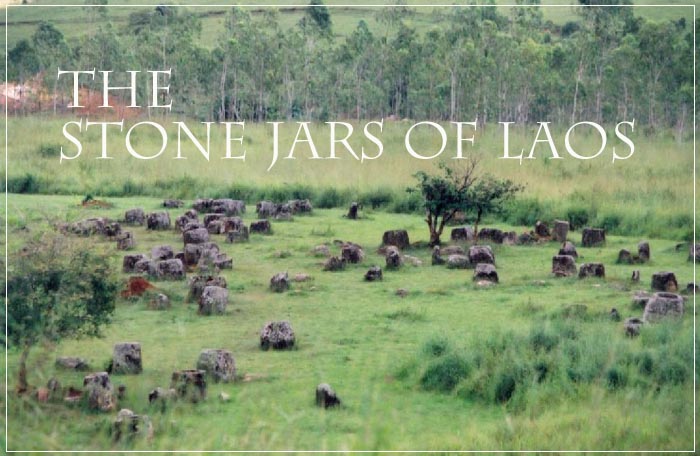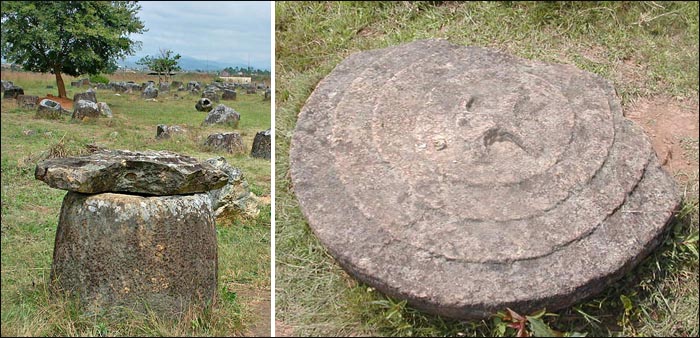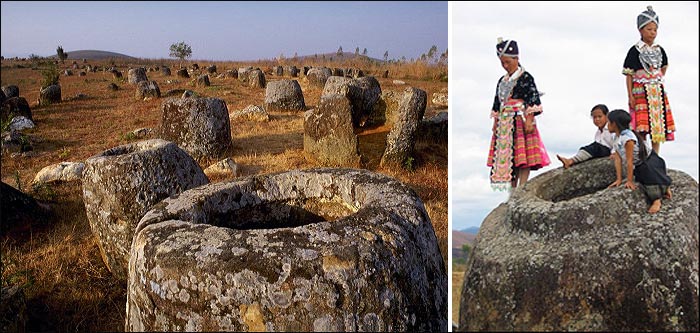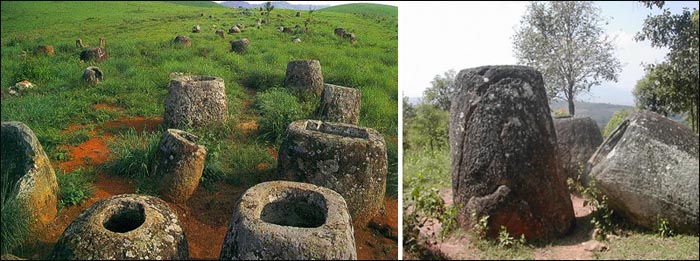
While the history of Europe is well understood and documented, Indochina has remained shrouded in mystery. The dense jungles of Laos harbor small villages and sparcely populated regions where literacy and record keeping are just now gaining popularity. And so, when early explorers found thousands of huge stone carved jars, spread across hundreds of miles, the questions of who could have made them and why they were made was not easily answered.
Located in Laos, near the Eastern border with Viet Nam, the stone jars are found in small clusters. At the most well known site, Ban Ang, the jars seem to be positioned on top of a steep hill. The jars, often weighing as much as 7 tons, appear to have been made at a different site and then moved to their present locations. They are from 3 to 10 feet in height and some span more than a meter in diameter. All are made from very hard stone, mostly granite but some have been carved from sandstone containing quartz, feldspar and mica.
Carving the jars, considering that there are thousands of them, must have been a remarkable feat for such a sparcely populated region. Scientists estimate that the age of these jars is around 2500 to 3000 years old. Some are so finely carved that it appears they must have been made on a huge lathe. Others are artistically carved in a prism shape. Some have even been found with human forms decorating them.

The jars perhaps at one time had circular lids. Some stone lids have been found with concentric circles decorating the top. It’s believed that most of the lids have been removed and used for other purposes, or perhaps sold to tourists by local villagers. The same can be said for the contents. Most are now empty.
If you ask the local people, tribes such as the Hmong and Yao, they will tell you that the jars were made in the 6th Century to hold wine. Legend has it that the ancient people once lived under a cruel king named Chao Angka, who mistreated his subjects. Citizens appealed to a king from the North, Khun Jevam, who came and liberated them. To celebrate this victory, Khun ordered that the jars be made to hold wine for a gigantic celebration.
 The
The
legend seems a bit far fetched since their carving and transport would have required a significant length of time — years, perhaps decades to complete. Also, there is evidence that many of the jars were made at different times, even centuries apart.
History we know:
French archaeologist Henri Parmentier first noticed the jars after he inquired about some glass and carnelian beads that were being sold and traded among the local tribes. The beads were apparently being pilfered from the jars along with other artifacts. This made Parmentier suspect that the jars, or urns, were actually tombs where bodies were placed with offerings. He documented a typical burial assortment as containing two black cooking pots, a couple of hand axes, an oil lamp, and the beads.
Additional research was done by another French archaeologist, Madeline Colani, who wrote about the jars in “The Megaliths of Upper Laos” (1930). Colani was born in 1866 and was the daughter of a Protestant biblical scholar. When she was 33 years old she moved to Indochina and taught natural history before obtaining her doctorate in Hanoi 11 years later. She is best known for her discovery of an ancient hunting culture, called the Hoabinhian, who thrived in Viet Nam about 18,000 years ago. Later, when she became aware of the stone jars, she moved to Laos to conduct her research.
Colani strongly believed that the jars were burial urns of Bronze Age people. She believed that the bodies were originally burned or partially cremated, then buried. Evidence of burnt bones in nearby caves seemed to support her theory. She believed the urns once contained the remains of “chieftains.” She documented three distinct styles: short, squat shaped urns, tall slender ones and prism shaped urns.
Colani summized that the hard stone was cut by bronze tools. She traced similar stone jars along an old caravan route that extended from the coast of Viet Nam, near Da Nang, to the Northern Cachar Hills in India. In some other locations along this route, human remains were found inside the stone jars.
If these jars were positioned along an ancient caravan route, it seems more likely that they were made to contain grain, rice or to store cargo associated with trade.
In 1994, Japanese archaeologist Eiji Nitta took a crack at the mystery by carefully excavating the earth surrounding some of the largest jars. As he dug about a foot of earth, he found several round stones that covered a pit containing bones. Nitta found no evidence of charcoal or burning associated with the human remains and no remains were found in the jars themselves. This suggested that perhaps the jars were a kind of monument or gravestone in which offerings, but no bodies, were kept.

It is possible that the jars had many uses throughout history, originally made for storage but later used as a burial urn. Perhaps some future archaeological work will reveal the “who” and “why” of these stone jars — but don’t hold your breath. Decades of war and, most recently, the dumping of unexploded munitions by US pilots returning to bases in Viet Nam have made the area one of the most dangerous places on Earth. Every year people are killed or lose legs, arms and eyes from these hidden bombs. This is a double edged sword for it not only prevents archaeologists from exploring the intact jars but it also prevents these artifacts from being looted by treausure hunters.
http://www.mondovista.com/granitepots.html
 .
.



